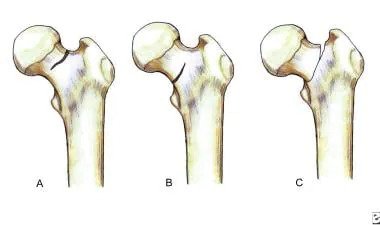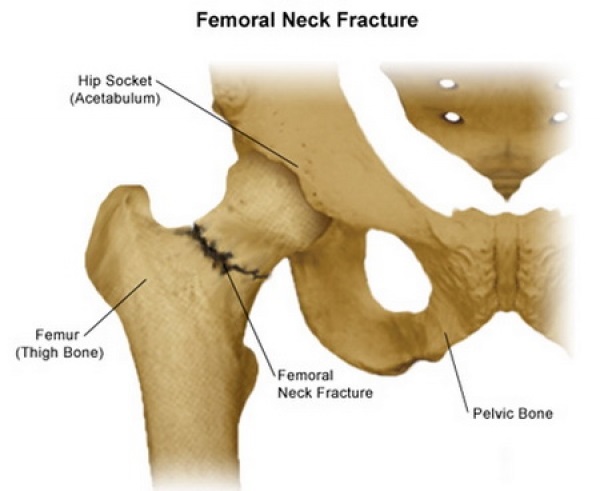Hip fracture is a common injury. A femoral neck fracture is a specific type of intracapsular hip fracture. Complications of hip fractures can be life-threatening. Age increases the risk of hip fractures. As a result of aging, bones tend to become weaker (osteoporosis). Older people are more likely to fall, one of the most common causes of hip fracture, due to medications, poor vision, and balance issues.
Hip fractures can be classified as intracapsular or extracapsular, with 60% of intracapsular fractures being displaced.
The hip is a joint of the ball and socket where the upper leg meets the pelvis. The formal head is at the top of your thigh bone (femur). It is the “ball” that sits in the socket. The femoral neck lies just below the femoral head.
The capsule contains the fluid that nourishes and lubricates the hip joint. This area’s fractures are divided according to where they occur along the femoral neck :
- Subcapital – femoral head and neck junction
- Transcervical – mild portion of the femoral neck
- Basicervical – base of the femoral neck
Subcapital and transcervical are intracapsular fractures. Basicervical fractures should typically be treated like extracapsular fractures, even though there is debate in the literature as to whether they are genuinely intracapsular or extracapsular.
A hip fracture always requires surgery along with physical therapy. A hip fracture can be avoided by maintaining bone density and preventing falls. Although anyone can suffer a femoral neck fracture, older persons with low bone density are much more likely to suffer. These fractures mostly occur in people older than 50 yrs. They are more common in women.
Blood vessels in the femoral neck can be torn, cutting off the femoral head’s supply of blood. The femoral head’s bone tissue will eventually die if the blood supply is cut off (a condition known as avascular necrosis), resulting in the bone’s eventual collapse. Where blood supply is not interrupted, fractures have a better chance of healing. Due to these factors, the kind of blood supply and the position of the break will affect how an older patient with displaced femoral fractures is treated.

WHAT CAUSES FEMORAL NECK FRACTURES?
The most common cause of femoral neck fracture is trauma. 50 yrs or having osteoporosis (a medical condition that weakens your bones) increases the risk of a femoral neck fracture. Another risk factor is bone cancer.
The most common cause of femoral neck fracture in older persons is falling. These fractures most commonly occur in younger people as a result of high-energy trauma, such as a car accident or a fall from a great height.
In children, femoral neck fractures are uncommon.
Femoral neck fractures can occur in athletes due to repetitive weight bearing on the bone (stress fractures) or from a severe collision on the field (traumatic fractures). Stress fractures of the femoral neck, which are most common in long-distance runners, begin as small cracks that grow over time with continued weight on the bone. In contact sports, a collision or a fall usually result in traumatic femoral neck fractures.
WHAT ARE THE RISK FACTORS FOR FEMORAL NECK FRACTURE?
Many factors increase the risk of a femoral neck fracture. Female gender, decreased mobility, and low bone density is risk factors for femoral neck fractures.
- Age and sex – Bone density and muscle mass decrease with age. In addition to eyesight and balance issues, aging can also increase the chance of falling.The chances of occurrence of Femoral neck fracture in females is three times more than in men. Women lose bone density more quickly than males do, in part because menopause’s decline in estrogen levels causes rapid bone loss. But men are also prone to dangerously low levels of bone density.
- Medical Condition – Chances of femoral neck fracture increase if :
- Osteoporosis – Bones become weak and more likely to break as a result of this illness.
- Intestinal disorders – Weakened bones can also result from conditions that decrease calcium and vitamin D absorption.
- Thyroid problems – Bones become fragile due to overactive thyroid.
- Balance problems – Peripheral neuropathy, Parkinson’s disease, and stroke can all increase fall risk. Low blood sugar levels and low blood pressure can both increase the risk of falling.
- Medication – If taken for a longer period of time, cortisone drugs like prednisone can weaken bones. In some cases, drugs or certain combinations of medications can cause dizziness, which can increase the risk of falling.
- Lifestyle – Weight-bearing exercise, such as walking, can weaken bones and muscles, increasing the risk of falls and fractures. Both alcohol and tobacco use can disrupt the natural processes of bone formation and maintenance, leading to bone loss.
- Nutritional issues – Young people’s diets lacking calcium and vitamin D reduce peak bone mass and raise their risk of fracture later in life.

FEMORAL RISK FRACTURE SYMPTOMS
Pain in the groin, which is worse when you put weight on your hip or try to rotate it, is the most common symptom of a femoral neck fracture. If you have osteoporosis, cancer, or another medical condition that affects bone, prior to the fracture, you might feel pain in your groin. Or you may have pain in the entire hip region.
Your leg may appear shorter than your uninjured leg if you have a femoral neck fracture, or your leg may be externally rotated with your foot and knee bent outward.
Symptoms of a femoral neck stress fracture typically appear gradually and may worsen with time.
WHAT ARE THE COMPLICATIONS OF FEMORAL NECK FRACTURE?
- Dislocation increased with arthroplasty surgery
- Nonunion
- Pneumonia
- Loss of muscle mass
- Raising the risk of injuries and falls
- Blood clots in the lungs or legs
- Death
HOW DO YOU DIAGNOSE FEMORAL NECK FRACTURE?
Depending on your symptoms and the position of your hip and leg, a doctor can determine if you have a hip fracture. Your doctor will prescribe an X-ray after conducting a physical examination to confirm the existence of a fracture and identify the specific area of the hip that is injured.
Your doctor may recommend a CT scan, MRI, or bone scan for a more thorough examination if your fracture is not visible in the images and you are still experiencing symptoms.

WHEN SHOULD YOU SEE A DOCTOR?
If you experience severe injury and can’t put weight on your hip, immediate medical care is required. Don’t put weight on the injured side.
Make an appointment to see your doctor immediately if you experience gradual, progressive groin pain and pain when you bear weight on one side so that they may check to see if you might have a femoral neck stress fracture.
HOW TO PREVENT FEMORAL NECK FRACTURE?
By choosing healthy lifestyles in early adulthood, you will increase your peak bone mass and reduce your risk of osteoporosis.
- Calcium and vitamin D – In general, 1,200 milligrams of calcium and 600 international units of vitamin D should be consumed daily by both men and women who are 50 years of age and older.
- Eyes checkup – If you have diabetes or an eye condition, have your eyes examined every other year or more often.
- Exercise – Walking is a weight-bearing exercise that helps maintain high bone density. Exercise increases overall strength and decreases the risk of falling.
- Use a walker or walking stick – Consult an occupational therapist or a health care professional if these aids might be useful if you don’t feel stable when you walk.
WHAT TREATMENT OPTIONS ARE AVAILABLE FOR FEMORAL NECK FRACTURE?
Treatment of femoral neck fracture includes- medication, surgery, and rehabilitation.
Pain medication is used for short-term relief from the pain. You may be advised to take bisphosphonates and other osteoporosis treatments by your doctor, depending on your age.
For hip fractures, emergency surgery is typically advised to reduce discomfort and quickly regain mobility. Non-operative care, internal fixation, and prosthetic replacement are the possible treatment.
The type of surgery required will also depend on whether your fracture has damaged the blood flow to your femoral head.
- Internal fixation – Internal fixation is a procedure in which metal pins or screws are used to hold your bone together so it can heal.
- Partial hip replacement – If the end of the bones is damaged, this procedure is used. The femur’s head and neck are removed and replaced with a metal prosthesis.
- Total hip replacement – Your upper femur and socket are replaced with a prosthesis during a total hip replacement. Research has shown that this type of surgery has the best long-term outcomes. It is also cost-effective.
FEMORAL NECK FRACTURE RECOVERY TIME
The degree of your femoral neck fracture, your general health, and the type of surgery performed will all affect how long it takes you to recover. Everybody recovers differently.
Early prevention of bone density prevents femoral neck fracture at a later age. Contact Zenith for proper diagnosis and treatment of femoral neck fracture. Reach out to us at 972-210-0033.
